The NVIDIA GeForce GTX 650 Ti Review, Feat. Gigabyte, Zotac, & EVGA
by Ryan Smith on October 9, 2012 9:00 AM ESTOverclocking: Power, Temperature, & Noise
Our final task is our look at the overclocking capabilities of our GTX 650 Ti cards.
Because the GTX 650 Ti is based on a lower clocked GK106 we should have more headroom to play with. Furthermore because GPU Boost is not present, and hence NVIDIA is not min-maxing GPU clockspeeds in the first place, there should be even more headroom to play with. For overclockers dissatisfied with overclocking in the world of GPU Boost, the GTX 650 Ti is going to be a return to old fashioned overclocking.
As an added benefit, because GPU Boost is not present NVIDIA is not operating these cards so close to their 1.175v limit. While it’s true the 1.175v limit is still in place, with the average shipping voltage being nearly 0.1v below that limit there’s some overvolting headroom to play with that GeForce 600 cards don’t typically get to experience.
| GeForce GTX 650 Ti Overclocking | ||||||
| Ref GTX 650 Ti | EVGA GTX 650 Ti SSC | Zotac GTX 650 Ti AMP | Gigabyte GTX 650 Ti OC | |||
| Shipping Core Clock | 925MHz | 1071Mhz | 1033MHz | 1033MHz | ||
| Shipping Memory Clock | 5.4GHz | 5.4GHz | 6.2GHz | 5.4GHz | ||
| Shipping Load Voltage | 1.087v | 1.05v | 1.087v | 1.087v | ||
| Overclock Core Clock | 1175MHz | 1175MHz | 1175MHz | 1175MHz | ||
| Overclock Memory Clock | 6.6GHz | 6.6GHz | 6.6GHz | 6.6GHz | ||
| Overclock Load Voltage | 1.162v | 1.15v | 1.162v | 1.162v | ||
When we’re looking at cards similar to a reference design it’s not unusual for those cards to top out at similar clockspeeds. It’s not even rare to have two cards top out at the same spot. But it’s highly unusual to have all 4 cards top out at the same point: 1175MHz core and 6.6GHz memory. Despite our best efforts each and every card would fail 1200/6.7 at some point, forcing us back down to the clockspeeds you see above. Perhaps what is most interesting is that none of the factory overclocked cards managed to push higher than our reference card, or even higher than one-another for that matter. Given what we’re seeing it looks like GK106 is naturally capable of 1050MHz+ clockspeeds, so the amount of failed chips coming out of factory overclock binning should be minimal.
Oddities aside, these overclocks are quite good. Compared to the reference GTX 650 these clocks represent a 250MHz (27%) core overclock coupled with a 1.2GHz (22%) memory overclock. These are far greater overclocks than what we’ve seen on any other GeForce 600 series card to date, once again thanks to the fact that the GTX 650 Ti’s clockspeeds are so low due in large part to a lack of GPU Boost. Budget overclockers will almost certainly be quite pleased with the GTX 650 Ti, though it’s worth noting that its closest competition is the similarly overclocking-friendly 7850.
Moving on to our performance charts, we’re going to once again start with power, temperature, and noise, before moving on to gaming performance.
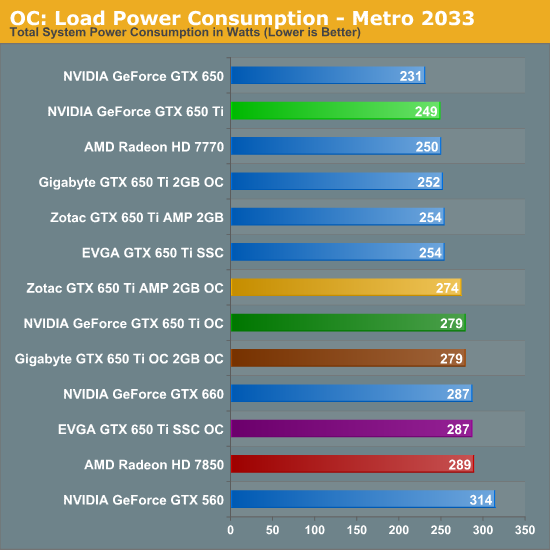
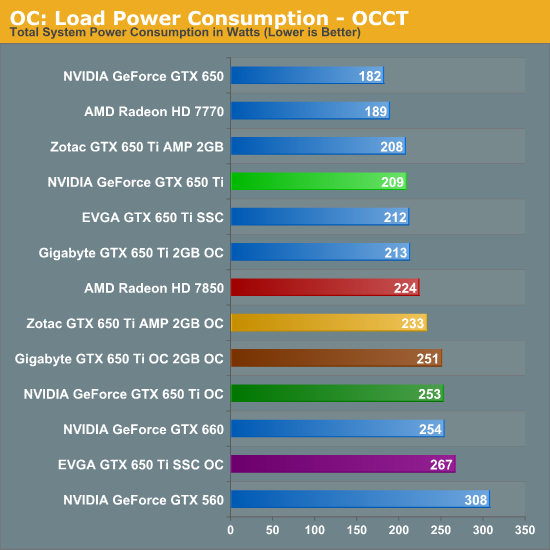
Unlike overclocking cards with GPU Boost, in the case of the GTX 650 Ti we are unquestionably overvolting the card. As a result the power consumption penalty for overclocking is quite harsh on a relative basis, though thankfully the GTX 650 Ti starts out low enough that the PCBs and the coolers are having no problem keeping up.
Overall, our overclocking efforts have pushed the power consumption of our GTX 650 Ti cards up by 30-40W, which puts power consumption just below the GTX 660 and 7850. The best performing card in this regard – that is, the card with the smallest increase in power consumption – is the Zotac card, followed by the close pairing of the Gigabyte card and the reference card, and finally EVGA’s card. This is one of those cases where a sample size of 1 just isn’t big enough, so there’s no clear reason why Zotac does so well or EVGA fares so poorly. Looking at temperatures it may be that we’re seeing temperature induced leakage, then again it may be that the hottest card is the hottest because of that power consumption.
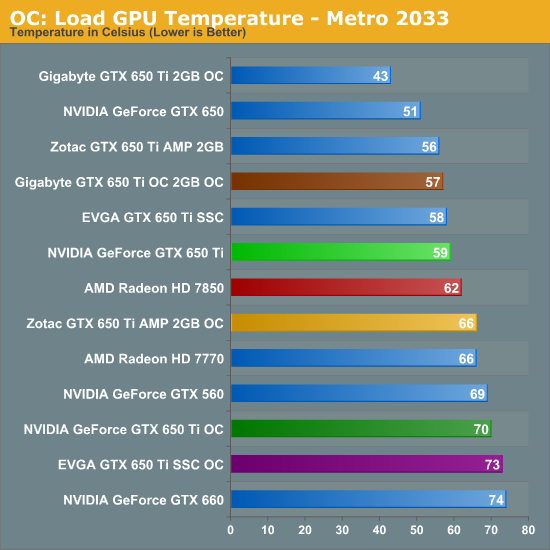
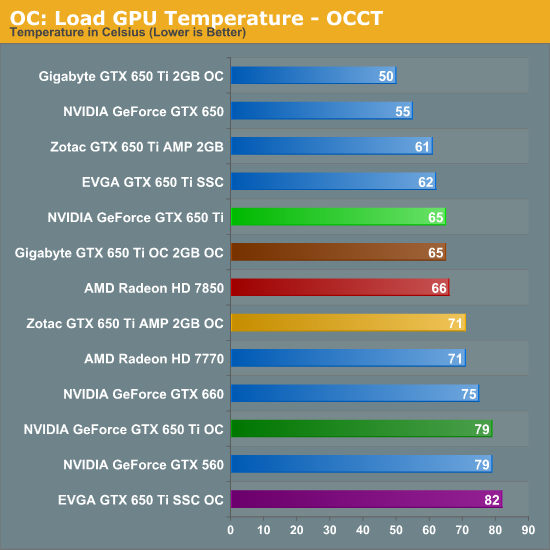
Next up is load temperatures. As we’ve already seen in our look at stock performance the Gigabyte card has a relatively aggressive fan curve, which is great for temperatures at the cost of noise. As a result even in the worst case scenario of OCCT it only hits 65C, 6C cooler than the next-closest overclocked card. That brings us to the Zotac card, which isn’t as cool as Gigabyte’s card but at 71C is still doing rather well. This is followed by the reference card at 79C, and finally the EVGA card at 82C.
Given the amount of power we’re channeling through these cards, it’s rather surprising just how well they hold up here. Even with these small coolers GPU temperatures are well into the safe zone, though the EVGA card is about as hot as we’d let such a card get under normal circumstances.
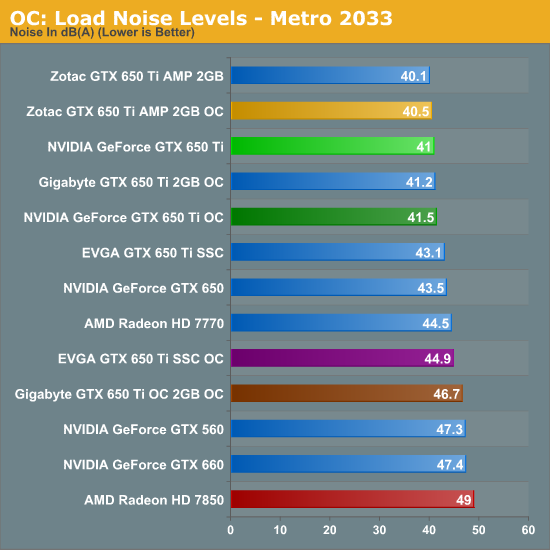
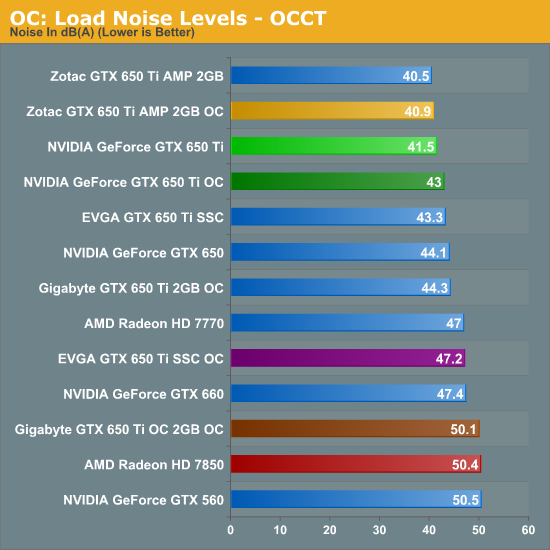
Moving on to noise, the cards that were previously doing well with stock settings continue to do well, while the rest of the cards fall further behind the leaders. The quietest card remains the Zotac, which even overvolted and running OCCT still doesn’t pass 41dB(A), which is simply incredible given the amount of power it’s pulling by this point. And as we’ve already seen its temperatures are respectable too, so Zotac seems to have hit the perfect balance here.
At the other end of the spectrum we have the EVGA and Gigabyte cards. Gigabyte continues to fall behind due to their aggressive fan curve, while the EVGA card and its poor overclocked temperatures require the card to push the fan even harder to keep up. Neither one of these cards is doing an acceptable job in light of what the Zotac card nor the reference card are achieving.










91 Comments
View All Comments
TheJian - Tuesday, October 9, 2012 - link
The 7850 is more money, it should perform faster. I'd expect nothing less. So what this person would end up with is 10-20% less perf (in the situation you describe) for 10-20% less money. ERGO, exactly what they should have got. So basically a free copy of AC3 :) Which is kind of the point. The 2GB beating the 650TI in that review is $20 more. It goes without saying you should get more perf for more $. What's your point?Your wrong. IN the page you point to (just looking at that, won't bother going though them all), the 650TI 1GB scores 32fps MIN, vs. 7770 25fps min. So unplayable on 7770, but playable on 650TI. Nuff said. Spin that all you want all day. The card is worth more than 7770. That's OVER 20% faster 1920x1080 4xAA in witcher 2. You could argue for $139 maybe, but not with the AC3 AAA title, and physx support in a lot of games and more to come.
http://www.geforce.com/games-applications/physx
All games with physx so far. Usually had for free, no hit, see hardocp etc. Borderlands 2, Batman AC & AAsylum, Alice Madness returns, Metro2033, sacred2FA, etc etc...The list of games is long and growing. This isn't talked about much, nor what these effects at to the visual experience. You just can't do that on AMD. Considering these big titles (and more head to the site) use it, any future revs of these games (sequels etc) will likely use it also and the devs now have great experience with physx. This will continue to become a bigger issue as we move forward. What happens when all new games support this, and there's no hit for having it on (hardocp showed they were winning WITH it on for free)? There's quite a good argument even now that a LOT of good games are different in a good way on NV based cards. Soon it won't be a good argument, it will be THE argument. Unfortunately for AMD/Intel havok never took off and AMD has no money to throw at devs to inspire them to support it. NV continues to make games more fun on their hardware (either on android tegrazone stuff, or PC stuff). Much tighter connections with devs on the NV side. Money talks, unfortunately for AMD debt can't talk for you (accept to say don't buy my stock we're in massive debt) :)
jtenorj - Wednesday, October 10, 2012 - link
No, you are wrong. Lower end nvidia cards(whether this card falls into that category or not is debatable) generally cannot run physx on high, but require it to be set to medium, low or off. AMD cards can run physx in a number of games on medium by using the cpu without a massive performance hit. There hasn't been a lot of time since nvidia got physx tech from ageia for game developers to include it in titles because developement cycles are getting longer and longer. Still, I think most devs shy away from physx because it hurts the bottom line(more time to impliment= more money spend on salaries and later release, alienate 40% of potential market by making it so the full experience is not an option for them, losing more money). Take a look at the havok page on wikipedia vs the physx page(which is more extensive than what even nvidia lists on their own site). Havok and other software physics engines are used in the vast majority of released and soon to be released titles because they will work with anyone's card. I'm not saying HD7770 is better than gtx650ti(it is in fact worse than the new card), but the HD7850 is a far better value(especially the 2GB version). Finally, it is possible to add a low end geforce like gt610 to a higher end AMD primary as a dedicated physx card in some systems.ocre - Thursday, October 11, 2012 - link
but it doest alienate 40% of the market.You said this yourself:
"AMD cards can run physx in a number of games on medium by using the cpu without a massive performance hit."
Then try to turn it all around???? Clever? Doubtful!!
And this is what all the AMD fanboys cried about. Nvidia purposefully crippling physX on the CPU. Nvidia evil for making physX nvidia only. But now they have improved their physX code on the CPU and every single game as of late offers acceptable physX performance on AMD hardware via the CPU. Of course you will only get fully fledged GPU accelerated physX with Nvidia hardware but you cannot really expect more, can you?
Even if your not capable of seeing the improvements Nvidia made it is there. They have reached over and extended the branch to AMD users. They got physX to run better on multicore CPUs. They listened to complaints (even from AMD users) and made massive improvements.
This is the thing with nvidia. They are listening and steadily improving. Removing those negatives one at a time. Its gonna be hard for AMD fanboys to come up with negatives because nvidia is responding with every generation. PhysX is one example, the massive power efficiency improvement of kepler is another. Nvidia is proactive and looking for ways to improve their direction. All these things complaints on Nvidia are getting addressed. There is nothing you can really say except they are making good progress. But that will not stop AMD fans from desperately searching for any negative that they can grasp on to. But more and more people are taking note of this progress, if you havent noticed yourself.
CeriseCogburn - Friday, October 12, 2012 - link
Oh, so that's why the crybaby amd fans have shut their annoying traps on that, not to mention their holy god above all amd/radeon videocards apu holy trinity company after decades of foaming the fuming rage amd fanboys into mooing about "proprietary Physx! " like a sick monkey in heat and half dead, and extolling the pure glorious god like and friendly neighbor gamer love of "open source" and spewwwwwwwing OpenCL as if they had it sewed all over their private parts and couldn't stop staring and reading the teleprompter, their glorious god amd BLEW IT- and puked out their proprietary winzip !R O F L
Suddenly the intense and insane constant moaning and complaining and attacking and dissing and spewing against nVidia "proprietary" was gone...
Now "winzip" is the big a compute win for the freak fanboy of we know which company. LOL
P R O P R I E T A R Y ! ! ! ! ! ! ! ! ! ! 1 ! 1 100100000
JC said it well : Looooooooooooooooooooooseeerrrr !
(that's Jim Carey not the Savior)
CeriseCogburn - Friday, October 12, 2012 - link
" You buy a GPU to play 100s of games not 1 game. "Good for you, so the $50 games times 100 equals your $5,000.00 gaming budget for the card.
I guess you can stop moaning and wailing about 20 bucks in a card price now, you freaking human joke with the melted amd fanboy brain.
Denithor - Tuesday, October 9, 2012 - link
Hopefully your shiny new GTX 650 Ti will be able to run AC3 smoothly...:D
chizow - Thursday, October 11, 2012 - link
According to Nvidia, the 650Ti ran AC3 acceptably at 1080p with 4xMSAA on Medium settings: http://www.geforce.com/whats-new/articles/nvidia-g..."In the case of Assassin’s Creed III, which is bundled with the GTX 650 Ti at participating e-tailers and retailers, we recorded 36.9 frames per second using medium settings."
That's not all that surprising to me though as the GTX 280 ran AC2/ACB Anvil engine games at around the same framerate. While AC3 will certainly be more demanding, the 650Ti is a good bit faster than the 280.
I'm not in the market though for a GTX 650Ti, I'm more interested in the AC3 bundle making its way to other GeForce parts as I'm interested in grabbing another 670. :D
HisDivineOrder - Tuesday, October 9, 2012 - link
Perhaps you might test without AA when dealing with cards in a sub-$200 price range as that would seem the more likely use for the card. Not saying you can't test with AA, too, but to have all tests include AA seems to be testing a new Volkswagon bug with a raw speed test through a live fire training exercise you'd test a humvee with.RussianSensation - Tuesday, October 9, 2012 - link
AA testing is often used to stress the ROP and memory bandwidth of GPUs. Also, it's what separates consoles from PCs. If a $150 GPU cannot handle AA but a $160-180 competitor can, it should be discussed. When GTX650Ti and its after-market versions are so closely priced to 7850 1GB/7850 2GB, and it's clear that 650Ti is so much slower, the only one to blame here is NV for setting the price at $149, not the reviewer for using AA.GTX560/560Ti/6870/6950 were all tested with AA and this card not only competes against HD7850 but gives owners of older cards a perspective of how much progress there has been with new generation of GPUs. Not using AA would not allow for such a comparison to be made unless you dropped AA from all the cards in this review.
It sounds like you are trying to find a way to make this card look good but sub-$200 GPUs are capable of running AA as long as you get a faster card.
HD7850 is 34% faster than GTX650Ti with 4xAA at 1080P and 49% faster with 8xAA at 1080P
http://www.computerbase.de/artikel/grafikkarten/20...
All that for $20-40 more. Far better value.
Mr Perfect - Tuesday, October 9, 2012 - link
I thought GTX was reserved for high end cards, with lower tier cards being GT. I guess they gave up on that?